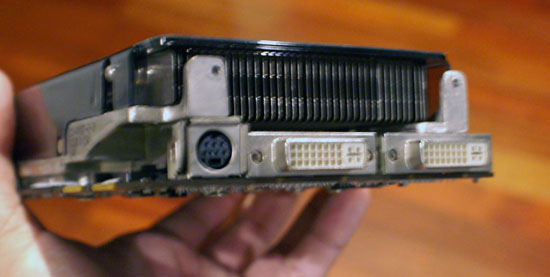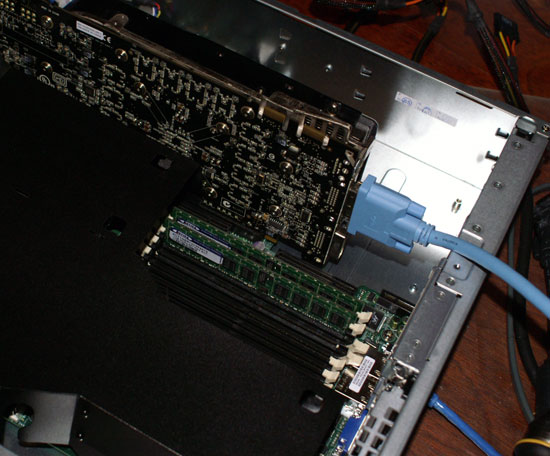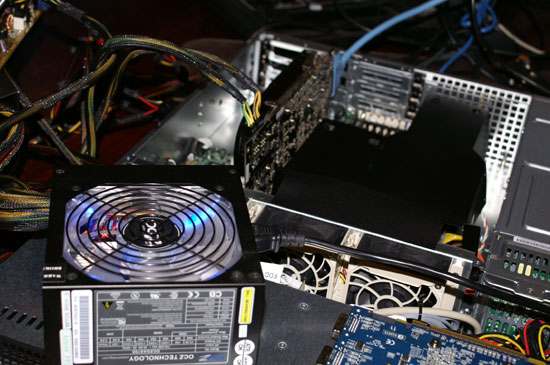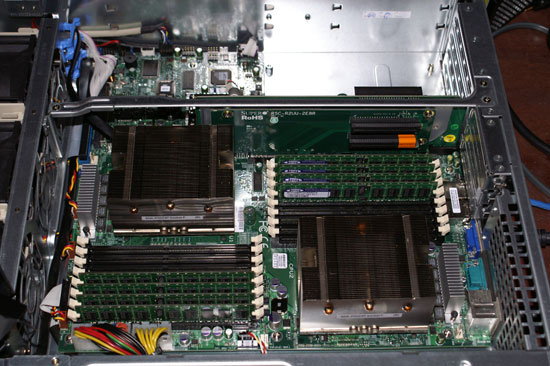AMD Phenom Preview: Barcelona Desktop Benchmarks
by Anand Lal Shimpi on September 10, 2007 12:03 AM EST- Posted in
- CPUs
The Methodology
We've been asking AMD for months now to let us benchmark Barcelona and Phenom, and for months we've gotten the same answer: not yet. When asked why, AMD would always give us some terrible lie about how it was for competitive reasons, but when we actually put our hands on Barcelona at Computex we realized that these chips were simply not ready.
The Barcelona launch is finally upon us and we've got to wait another 45 - 60 days before we'll be able to bring you a review of Phenom, well, not exactly. Back when the Opteron launched, AMD was in a very similar situation to the one it's in today; AMD needed K8 to remain competitive, and it had been delayed so much that we were beginning to wonder if AMD would ever get the chip out on time. When the K8 finally launched, it was server-only but we took one of those server-only motherboards and ran a bunch of desktop tests on it to predict forthcoming performance.
We cracked open the Barcelona server and made some modifications; while the on-board ATI ES1000 graphics is sufficient for use as a server, it'd be too limiting for our desktop benchmarks. Luckily the Supermicro motherboard in the system had a plethora of PCIe slots, we just needed to gain access to them.

The PCIe Riser we removed from the system
We pulled out the PCIe riser card which plugs into the motherboard's sole x16 slot and divides it into a pair of x8s, then we modified a GeForce 8800 GTX by removing the backplate cover so we could just stick it into the open server.

The modded 8800

The 8800 GTX installed, the server is not really intended to be used like this
The end result was, as Johan put it, us using "such a beautiful, noble machine for such plebian activities". We couldn't help it, while AMD has already contacted us about Phenom briefings, we couldn't wait that long to get an idea of what we can expect from AMD on the desktop.

We needed an external PSU to power the graphics card, the server didn't have any PCIe power connectors
Barcelona is currently limited to DDR2-667, we were unsuccessful with attempts to run the memory any faster. Like all other MP Opterons, Barcelona requires the use of registered DDR2 memory, which is inherently slower than the unbuffered stuff we use on desktops. Because of these limitations we refrained from running any comparative benchmarks to desktop Athlon 64 X2s, instead we chose to run a single quad-core Opteron in our server platform against a pair of dual-core Opterons to simulate Phenom vs. K8 on the desktop.

The Opteron server, 2 CPUs, 8 DDR2-667 DIMMs
Keep this in mind as you're looking at these results, at best all we're offering is an idea of, at a minimum, how much faster Phenom will be over an identically clocked Athlon 64 X2. As Phenom is a more data hungry CPU than its predecessor, it will rely more on having a faster memory subsystem so the performance improvement could be even greater when we measure it on the desktop. That being said, at least we can set expectations within some amount of reason by performing this investigation.










70 Comments
View All Comments
Anand Lal Shimpi - Monday, September 10, 2007 - link
That's the first thing I tried, it didn't work :)Take care,
Anand
hirschma - Monday, September 10, 2007 - link
That's sad, truly. Any inside scoop as to whether a Socket F FX will be seeing the light of day anytime soon?
Thanks for the reply, anand.
Visual - Monday, September 10, 2007 - link
hey, that's bad news, but good that you let us knowand i'm sure if you spam asus a bit they'll give you a bios fix before they even make it official :P
Visual - Monday, September 10, 2007 - link
Same thing i posted two posts up :pThe only 4x4 (official name is quadFX btw) board out now is ASUS L1N64-SLI WS, k8 opterons work fine in it... lets hope these will too.
Though it probably will take a bios update to at least show the cpu name properly.
Would with 4 pci-e slots and SLI support, overclocking features, plenty of room around the sockets (for a dual-socket board anyway) this would make an excellent desktop.
I also hope more quadFX boards come out soon. I like the asus, sure... but at least an update to support pci-express v2 would be good. If they also managed to fit more memory slots and all 4 gigabit lan ports that are supported by the chipset, it would be even better. And having choice between more brands would be a good thing too.
TA152H - Monday, September 10, 2007 - link
This is a review that should not have been made. The Barcelona review by itself was enough to let people know what they could expect from a Phenom, instead of introducing bad data onto the web. First of all, the Barcelona is different from the Phenom, they have different cache arrangements, and that does make a difference.And then, the chart about the Barcelona competing with two dual-core K8s is so bad I wanted to scream. The pair of dual cores can access memory at the same time, the single quad-core can not. This is not an advantage a K8 will have over a Phenom in equivalent configurations.
I know you need hits for sites like this, but this is just a bad review. It's like telling everyone they are too stupid to really get an idea from real information, and instead need for you to use misinformation due to bad comparisons, to tell them what you think the performance will be like. It's bad.
sdsdv10 - Monday, September 10, 2007 - link
Actually, if you read the beginning of the article AMD asked them (Anandtec) to do this.Furthermore, AMD was responsible for the system the CPU's were tested on.
Don't go bashing Anandtech for doing something AMD asked them to do, just because you don't like the results.
MadBoris - Monday, September 10, 2007 - link
It wasn't a review, it was a preview.It should be taken with a grain of salt, and yes the dual K8's is not the best comparison, it opens up even more questions to what the real world penalty from two sockets actually is.
But all of us really want to know what it means for us, not just integer intensive tests but FP like for games, etc.
Probably the most informative benchmark to me would have been the performance of a single core K8 vs K10, which would have showed me the improvements of the architecture and I can extrapolate alot from there. Running onecpu boot option with Vista could have done that, but they were pressed for time.
Also Supreme Commander is one of the most CPU dependant games around, with rendering and sim threads, so it will clearly show CPU granularity probably better than any other game currently.
leexgx - Monday, September 10, 2007 - link
we need to see Single Thread tests as well to see what an k8 cpu running in 1 cpu mode that an k10 can do in 1 cpu mode (both running at the same 2ghz speed)it has to be faster then my 3.1ghz cpu if i am going to get it (Quad be nice tho)
and the tests should be done under XP if ony 1 cpu is going to be used Vista has to many services that can interfere with results (booting up into vista now is now resulting in Constant hard disk use whare as my XP setup just the start thats an little slow when desktop is first loading after that programs are faster)
MadBoris - Tuesday, September 11, 2007 - link
That is what I said earlier as well, single threaded comparison between K8 and K10 would tell me alot...
So http://www.techreport.com/articles.x/13176/5">techreport to the rescue.
Cinebench single thread: (higher better)
Opteron 2218 HE (K8 2.6GHZ) - 2449
Opteron 2360 SE (K10 2.5Ghz) - 2385
No architectural improvement witnessed here on a single core with k10.
Myrimatch: (lower better)
1 thread Opteron 2218 HE (K8 2.6GHZ) - 506
1 thread Opteron 2360 SE (K10 2.5Ghz) - 656
2 thread Opteron 2218 HE (K8 2.6GHZ) - 353
2 thread Opteron 2360 SE (K10 2.5Ghz) - 373
Decent improvement witnessed here on a single thread, but then 2 threads on K10(373) falls much closer to the level of K8(353). This protein benchmark likely reacts to some memory benefits, because other tests don't show raw computational advantages.
STARS Euler3d: (higher better)
1 thread Opteron 2218 HE (K8 2.6GHZ) - .53
1 thread Opteron 2360 SE (K10 2.5Ghz) - .54
2 thread Opteron 2218 HE (K8 2.6GHZ) - .96
2 thread Opteron 2360 SE (K10 2.5Ghz) - .96
No tangible architectural improvement witnessed here on a single core with k10 OVER k8.
So it looks like the actual core architecture is not all that much better on K10 over K8. Surely nothing like the advance we saw with a Core 2 architecture (Although Intel had alot of room for improvement over prescott).
The K10 begins to really advance and scale with 4 threads (probably a product of 2 socket penalty with K8). Scaling beyond 4 threads is obviously where the K10 will show it's legs, and 2 - 4 sockets on K10 is where it will scale better than Intel.
IntelUser2000 - Tuesday, September 11, 2007 - link
Madboris, your analyzation on Myrimatch tests are wrong. Let's take a look at your post about Myrimatch:It's time in seconds, meaning at one thread, Opteron 2218 HE is approximately 30% faster than the 2360 HE. In 2 threads, Barcelona does better as it closes up to the K8, but still doesn't have an advantage.